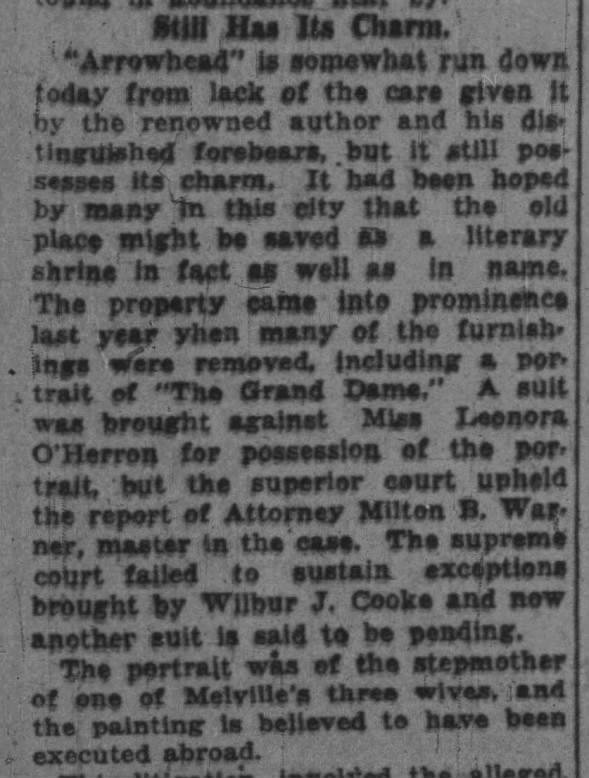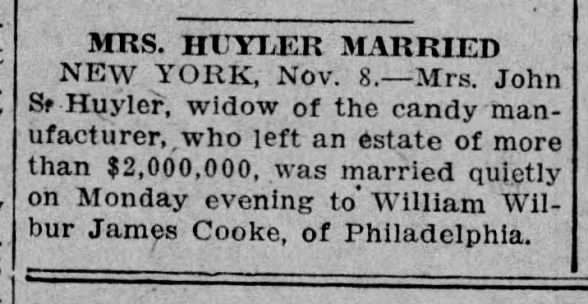Hardcore Melvilliana fans might remember Leonora O' Herron, the respected Pittsfield antiques dealer who conducted the estate sale at Arrowhead in the summer of 1927, after Herman Melville's nieces sold it to Robert E. Kimball. Along with all the usual household furnishings, the 1927 sale featured unspecified "books from the library of Herman Melville," as previously shown on Melvilliana:
https://melvilliana.blogspot.com/2019/08/friend-of-bessie-remembers-herman.html
Before the sale, Miss O'Herron had been working on the appraisal of more unique and valuable items, among which was a portrait in oil known locally as "The Grand Dame." A shady New York dealer named Wilbur J. Cooke tried to buy the alluring work when a friend of Miss O'Herron was minding the shop. The well-meaning friend who mistakenly sold The Grand Dame to Cooke for fifty dollars was Robert Frost's daughter Lesley W. Frost, then proprietor of the Open Book Shop in Pittsfield. For her part Miss Frost was innocent of any fraud, and too good to wonder why Mr. Cooke had to borrow the down payment of $5.
When she found out what had happened, Miss O'Herron promptly returned the five bucks, whereupon Cooke took her to court. Verdict: No Sale. A few years later the New York dealer was exposed as a crook after selling a lot of fake Lowestoft china to a Boston collector. The gifted swindler dealt in fake paintings too, and sold at least one phony portrait of George Washington as the work of Gilbert Stuart. Acknowledged in the papers as "one of the cleverest art racketeers on record" (New York Daily News, April 2, 1933) Wilbur J. Cooke sought refuge in various mental hospitals in New York State.
DEALER LOSES SUIT FOR MELVILLE'S PICTURE[Special Dispatch to The Herald]PITTSFIELD, March 29 -- Atty. Milton B. Warner, as master, found for the defendant today in a suit in equity filed in superior court by Wilbur J. Cooke of New York, dealer in portraits and antiques, against Miss Leonora O'Herron of 120 South street, Pittsfield, also a dealer in antiques, to recover a portrait valued at more than $350 called "The Grand Dame," owned by Maria G. Morewood and Catharine G. Melville of Elizabeth, N. J., heirs of Herman Melville, author.
The picture was taken from Melville's old home, Arrowhead, Pittsfield, to Miss O'Herron's shop for appraisal and sale. In her absence Oct. 23, last, it was sold for $50 by Miss Lesley T. Frost, who was in charge temporarily. Mr. Cooke made a deposit and said he would call later. When he appeared Oct. 28 and demanded the picture it was refused him. Mr. Warner found at the time it had not been appraised and Miss Frost had no authority to sell it.
--Boston Herald, March 30, 1927.
A recap in the Berkshire Evening Eagle of March 2, 1933 stated that Allan Melville's daughters "had refused offers of $500" for the painting. Adjusting just for inflation that's $8,000 today, at least, irrespective of fluctuations in the market for rare art. Who was the woman portrayed as "The Grand Dame" in this unusual and pricey work? Berkshire journalists dubiously identified the subject as "the step mother of one of Herman Melville's wives."
"As a matter of interest, Attorney Warner asked about the history of the portrait in question. Herman Melville, the author of "Moby Dick," who lived at Arrowhead, was twice married and the portrait depicts a stepmother of one of his wives. On account of its having always hung in the Melville, house, now owned by his nieces, Mrs. William Morewood and Miss Katherine Melville, it has a distinct Melville association, although not a portrait of a member of the Melville family." -- The Berkshire County Eagle, December 10, 1926.
"The painting was of the step mother of one of Herman Melville's wives and was taken from "Arrowhead," home of the famous writer of sea stories on Holmes road."
-- Berkshire County Eagle, April 6, 1927
More generously, if not accurately or helpfully, a later report in the same newspaper gave Herman Melville three wives:
"The portrait was of the stepmother of one of Melville's three wives, and the painting is believed to have been executed abroad." -- Berkshire County Eagle, July 14, 1927.
 14 Jul 1927, Thu The Berkshire Eagle (Pittsfield, Massachusetts) Newspapers.com
14 Jul 1927, Thu The Berkshire Eagle (Pittsfield, Massachusetts) Newspapers.com
Not counting Fayaway in Typee
However, companion portraits of Catherine Van Schaick Gansevoort and Peter Gansevoort were in fact donated in 1985 to the Berkshire County Historical Society. Formerly, as reported in the Berkshire Eagle on December 13, 1985, both portraits "hung at Arrowhead for a number of years." Maybe Herman's maternal grandmother Catherine was the mysterious and elusive Grand Dame.
Here's another more promising angle. Besides Herman's younger brother Allan, another Melville with multiple wives was their uncle Thomas Melvill, Jr. The first wife of Major Thomas Melvill Jr was "Fanny" Fleury aka Françoise Raymonde Eulogue Marie des Doulouers "Fanny" Lamé-Fleury. Aka Françoise Lamé-Fleury. Call her Fanny. Thomas Jr. and Fanny got married in 1802, in Paris. As avowed in writing by Charlotte Hoadley (Herman Melville's niece), the Melville family steadfastly regarded this Fanny as "an adopted daughter of Madame Recamier" and held "that she was married to Thomas Melville from Madame Recamier's salon.""believed to have been executed abroad."

Copies of famous paintings of Madame Récamier by François Gérard and Jacques-Louis David are listed in a miscellaneous inventory made by Herman's wife Elizabeth Shaw Melville. From the memoranda of Elizabeth Shaw Melville, transcribed by Merton M. Sealts, Jr. in The Early Lives of Melville (University of Wisconsin Press, 1974) pages 167-177 at 176:
<Madam Recamier by Gerard-costume of Consulate-bare feet and neck on a Roman chair in a niche beneath a pillared arch-Same by David represents her leaning back on a rustic seat>
In a footnote Sealts points out that Elizabeth Melville's entry on images of "Madam Recamier" has been canceled in pencil. The crossed-out listing could mean these items were sold or bequeathed after Herman Melville's death in 1891, as John Bryant guesses in the first volume of Herman Melville: A Half Known Life (Wiley-Blackwell, 2021). Not that either of these items is THE Grand Dame, necessarily. They seem to be prints, whereas contemporary newspaper accounts specifically describe The Grand Dame as an oil painting. Nevertheless, the references to well-known paintings by Gerard and David in Elizabeth Melville's memoranda certainly attest to her familiarity with popular images of Madame Récamier. And her husband's, presumably.
Because Supreme Court Justice Graham Witschief could find no evidence that gray-haired, dreamy-eyed Wilbur J. Cooke, alleged swindler and fugitive from Massachusetts' justice, is insane, he refused to grant appointment of a lunacy commission when application was made before him in a special term at Newburgh yesterday.Cooke, who was brought into court on a writ of habeus corpus, was remanded to the Goshen County jail until next Friday, when his attorney, Charles A. White, hopes to present evidence to warrant the appointment of a commission.Cooke has been a patient at Interpines Sanitarium in Goshen for a year, unknown to Massachusetts police, who have been on his trail. -- Newburgh, NY Beacon News, March 11, 1933; found on fultonhistory.com

Incredible as it seems, Cooke managed to avoid criminal charges and extradition to Massachusetts.
GOSHEN -- Wilbur J. Cooke, arrested at Interpines here yesterday as a fugitive from justice at request of the Boston Police Department sat in a hospital cell in the county jail today attired in pajamas and a lounging robe and working a jig saw puzzle while all concerned awaited the next move....
... The prisoner has been talkative in jail and has seemed to prefer religion as a topic of conversation. Pajamas, a lounging robe, and slippers were brought to the jail by an attendant at the sanatorium. -- Middletown Times Herald, March 3, 1933.
In the last hour, literally, an influential sister, Emma Cooke Chase of Monticello, helped persuade a judge to find him insane after all. Wilbur Cooke's official medical diagnosis, made by two sanitarium doctors (Frederick W. Seward Jr. and Clarence A. Porter), was dementia praecox, premature or "precocious madness." Instead of enduring a trial and serious prison time for larceny, he got legally committed to the State Homeopathic Hospital at Middletown, New York.
In yet another twist, it turned out that Wilbur J. Cooke's second wife was a very wealthy lady.

The second wife of William Wilbur James Cooke died in late November 1933. Mrs. Rosa F. Huyler Cooke willed her estate to husband Wilbur and two sons from her previous marriage to candy maker John S. Huyler. Years later, a New York jury awarded a portion of Wilbur's inheritance, $50,000 plus $20,000 interest, to Clinton I. Nash, one of the Boston art collectors whom Cooke had defrauded (Middletown Times Herald, April 9, 1937). Wilbur still resided at the State Hospital in Middletown.

In case you're wondering, Cooke had married suspiciously well the first time around, too. Born in 1842, Jane F. Levick Jackson, daughter of Quaker diarist and abolitionist Samuel J. Levick, was actually 68 when she rather unexpectedly married young and good-looking William W. J. Cooke, then described as "an artist's model, big, broad-shouldered, and 25" (Washington Post, October 19, 1910; reprinting an article in the Philadelphia North American in which Cooke's bride was alleged to be 77 years old). Jane L. Jackson Cooke died four years later in 1914; and two years after that Cooke wedded the former Mrs. John S. Huyler.
Cooke is remembered in Pittsfield for his suit against Miss Leonora O'Herron, proprietor of an antique shop on South Street. In Miss O'Herron's absence, a portrait was sold, by mistake, to his agent by a volunteer assistant, Mrs. Leslie Frost Francis. She was unaware of the fact that the picture had been left by the owners who had refused offers of $500 for it.
The picture had belonged to the late Herman Melville, the author, and was owned by his heirs. Cooke's agents bought the picture for $50 and paid $5 down, getting a receipt but leaving the picture pending payment in full. When Miss O'Herron returned his deposit and refused to sell the picture, Cooke brought suit, the case being tried by attorney Milton B. Warner as master. Mrs. Doran was one of Cooke's witnesses at the trial. Cooke lost and appealed to the superior court, but the case was dropped before coming to trial.
The Morewood family in New York, owners of the picture, decided to keep it and still have it in their possession. -- Berkshire Evening Eagle, March 2, 1933
Who got the Morewoods' Grand Dame and where is she now?





Huyler was the maiden name of Sarah Morewood.
ReplyDeleteThanks! Cousin of the candy maker?
Delete